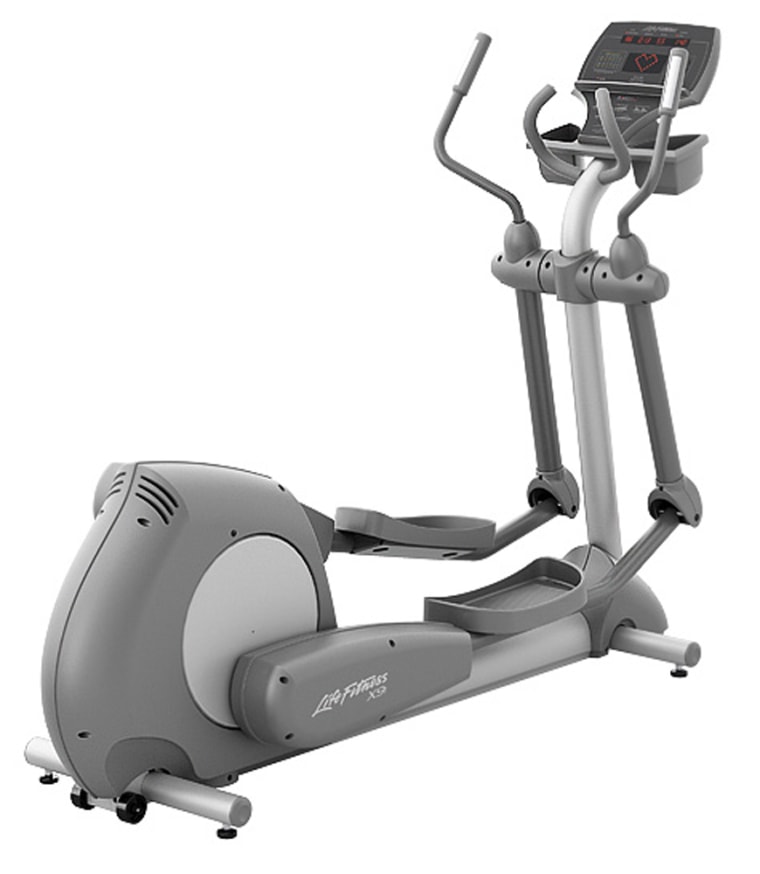A Welso Cadence C44 treadmill comes with a thumb pulse sensor to measure heart rate, interactive programs, an extra-large LCD display that tracks speed, time and distance, a water bottle holder and a magazine rack — all for a price tag of $299.53 at Wal-Mart.
A top-of-the line treadmill from specialty shop Life Fitness, equipped with both hand-sensor-and-chest-strap heart rate monitoring systems, 18 programmed works-outs and a LCD entertainment system — a 12-inch, touch-screen television that switches between regular TV reception to work-out data — retails for $6,999.
Which machine ends up in your basement or the corner of your living room has little do with the wonders of technology (although we really do appreciate the new technology) but rather your fitness regime and budget.
Treadmills top the list when it comes to sales of home exercise equipment, says Larry Weindruch, a spokesperson for the National Sporting Goods Association. In 2004, treadmill sales totaled $2.8 billion compared to $696.2 million for home gyms and $287.2 million for free weights.
Most consumers spend an average of $635 for a treadmill, which they usually purchase from a department store such as Sears.
Sales of elliptical trainers lagged behind at $216.4 million in 2004. But sales of the low-impact stationery machines increased 20 percent in one year, up from $183.6 million in 2003. Weindruch speculates it's because elliptical trainers are the new, hot item. Elliptical trainers range in price from $149 for an Orbitrek machine at Amazon.com to $4,199 for the X9i at Life Fitness.
Bigger than a breadbox
Getting the equipment to your home and finding a place for it is a big issue. A multistation home gym requires about 50 square feet, says Dr. Cedric Bryant, PhD, chief exercise physiologist for the American Council on Exercise, a non-profit fitness certification organization. A treadmill takes up about 30 square feet and elliptical trainers require about 20 square feet.
Then there's the price. An iPod upgrade is one thing, but the average consumer isn't likely to to replace a home exercise machine when a new model hits the showroom floor. Fortunately, home exercise equipment doesn't usually go through the same wear and tear that some other consumer electronics might.
Unless you have an extremely large family of competitive athletes, "a typical (home) treadmill is not going to take the beating of a club model," says Weindruch.
Like most shopping expeditions, choosing the right home exercise equipment requires researching the product, checking out warranties and return policies, comparing prices at different vendors and eventually snagging the best deal. Unlike many other shopping adventures, the consumer is encouraged to test drive the equipment.
"What it feels like depends on if you'll use the equipment," says Drew Surinsky, a Chicago-based sports physiologist, who is also a USA Triathlon-certified triathlon coach and an ACE-certified personal trainer and swim coach. "If it doesn't feel right, you're not going to use it," he says.
As for technical features on treadmills, when it comes to horsepower, "more is better," Surinsky says. More horsepower puts less stress on the machine and the equipment will last longer. He also advises looking for the "continuous duty rating," which is the rating for the motor during continuous and steady use rather than a rating established for peak performance.
A high-quality belt will last longer than a less expensive one. Two-ply is generally better than one-ply, he says. Roller size also affects the life of the belt. Bigger rollers create less tension on the belt. Surinsky recommends a roller size of 2 inches or more.
Shock absorption is a key factor. "If there is no shock absorption, you'll be absorbing the shock," says Surinsky. The material the deck is made of contributes to its ability to absorb shock. Most decks are made of a durable fabric. Woodway, a Waukesha, Wis.,-based company that manufactures high-end machines, makes a treadmill with a rubber deck. It's pricey but the "best feeling treadmill" I've ever used, says Surinsky.
Bryant also stresses that it's important to "pay attention to how the equipment fits." When shopping for an elliptical he suggests considering stride length and the width between the pedals. Make sure the stride is not too long or too short. Pedals closer together are usually more comfortable for the hip and knee.
A heart rate monitor is essential. "It's the best way to make sure you are moving at the right speed," says Surinsky. A basic heart rate monitor for about $40 will work just fine in most circumstances, he says.
Do you need fancy features?
Pre-programmed routines or even on-the-fly programs are not essential, although they tend be packaged with the higher end machines. Many of these programs, some of which can be downloaded off the Internet, are not necessarily good, says Surinsky, who still uses the manual setting on the treadmill at the gym where he works out.
As for those built-in entertainment systems, you might do better to just put a flat-screen television on a cabinet in front of the machine.
The equipment should "hit your sweet spot," which varies according to the individual, Bryant says. "The wise shopper focuses on the internal workings more so than the bells & whistles."
Surkinsky seconds the sentiment. "Treadmills with fans are nice, but if it's a choice between fancy programs and good construction, go for the construction." He suggests that most consumers would be better off with a fitness center membership, where there is a variety of club-quality equipment rather than using one piece of lousy equipment at home.
The details, however, are not always in the equipment. "Some people, who are committed to exercise, buy a cheap piece of equipment and use it intelligently," he says. Others with great intentions may invest thousands of dollars and use it a clothesline.
